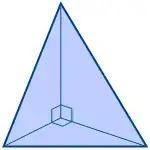Of the many nice proofs of the Pythagorean theorem, one large class is the "dissection" proofs, where the sum of the areas of the squares on the two legs is shown to be the same as the area of the square on the hypotenuse. For example:

One generalization of the Pythagorean theorem is De Gua's Theorem, which concerns right-angled tetrhaedra:

For such a tetrahedron, the areas $A,B,C$ of the three "legs" are related to the area $D$ of the "hypotenuse" by the formula $$ A^2 + B^2 + C^2 = D^2. $$ See here for a simple proof of this theorem. Note that both sides of this equation have units of area-squared, i.e. four-dimensional volume.
My question is:
Is it possible to prove De Gua's Theorem using a "dissection" in four dimensions?
There's no reason to be strict about the definition of a "dissection" -- any proof involving four-dimensional volume would be welcome. For example, it would certainly be interesting to have a proof of De Gua's Theorem that involves shearing in four dimensions.